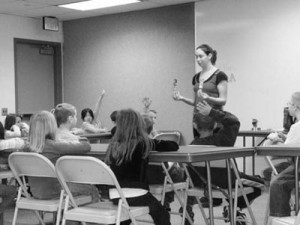The Arts-in-Education program is a series of integrated, interdisciplinary lessons designed for grades kindergarten through second in the Tyrone Area Elementary School.
The presentations rely on direct observation of works of art from the Southern Alleghenies Museum of Art’s education collection. This program provides students with age-appropriate lessons, each emphasizing creation, technique, history, criticism and aesthetics.
Opportunities are provided for students to create and respond to art, learn about the placement of art in culture and history, and make judgments about the quality of art.
Lessons for this year included: Kindergarten – book illustrations; and grades first and second – Native American art.
Funding for the program is provided by a grant through the PA Council of the Arts, the Southern Alleghenies Museum of Art (SAMA), the PTO and the Tyrone Area School District. Earlier this year the second through fourth grades were involved in the Artist-in-Residence program, which was part of that same grant.
All this week, from January 21-25, Altoona native and local artist Pamela (Snyder) Etters served TAES as the art education coordinator. She attended Altoona Area High School and earned a Bachelor of Fine Arts degree from Penn State University, specializing in drawing and painting.
Etters’ current focus is in murals and she particularly enjoys public art (murals about a community history), working alongside the community to create a mural that can be enjoyed and perhaps learned from as well.
She is currently working on a series of paintings based on war veterans.
As TAES’s art education coordinator this week, Etters is discussing book illustrations with the kindergarten students; reading the kids a book and discussing how important the pictures are and how they help the students understand what they are reading.
Furthermore, Etters has the young students apply what they learned by writing a sentence that involves filling in the blanks. Example: “In the (student’s favorite season), I like to (fill in student’s activity).” Next, she has the kids draw a picture illustrating the students’ sentence.
In first and second grades, Etters has the students learning about artifacts. She provides three examples of artifacts from Native American Culture, such as kachina dolls, gourd rattles and a corn husk basket. The students then discuss the function of each piece, how it is made, and the symbols the Native Americans incorporate into their everyday objects.
After discussion, the students create a Native American artifact; either a gourd rattle or a blanket, and they put Native American symbols on their artifact based on what they have learned.
Etters said she really loves the job she is doing at TAES. She thinks art is a very important part of education, adding, “Art is so universal and there are no boundaries. People of all ages, backgrounds or disabilities can understand and learn from art.”
“Interacting with the kids is so exciting and despite the fact that I teach the same lessons over and over, they are never the same,” stated Etters.
She said one of her favorite quotes is by Pablo Picasso who said, “Every child is an artist. The problem is how to remain an artist once he grows up.” She thinks revisiting these “child artists” keeps herself grounded and reminds her why she is an artist.
“I believe the kids are really enjoying themselves. They are eager to participate in discussion by asking and answering questions,” said Etters.
“Once discussion concludes, they enjoy applying what they have learned to making their own drawings.”
